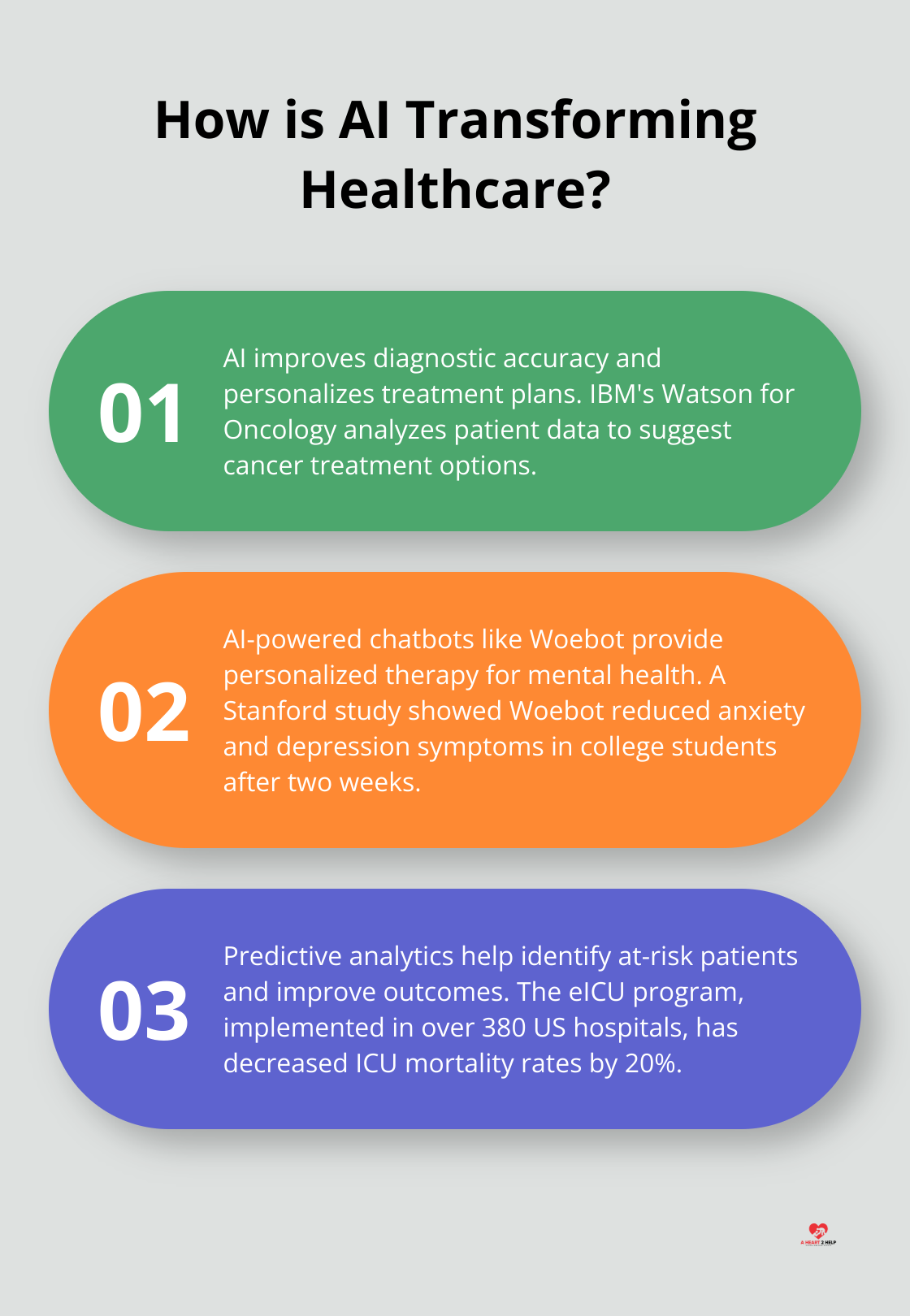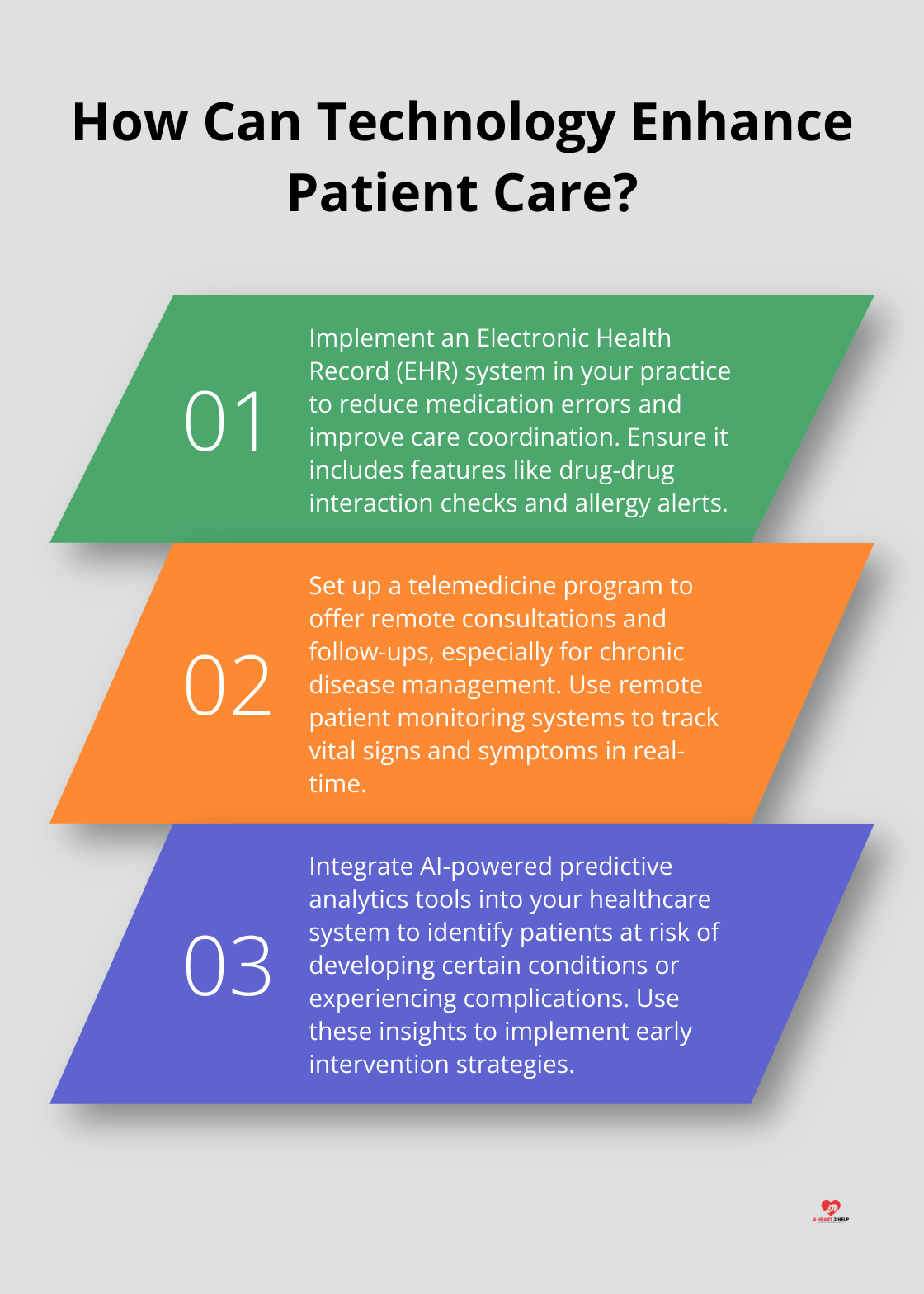Technology is revolutionizing healthcare, offering new ways to enhance patient outcomes and streamline medical processes. At A Heart 2 Help, we’re passionate about improving patient care through technology.
In this post, we’ll explore how electronic health records, telemedicine, and artificial intelligence are transforming the healthcare landscape. These advancements are not just improving efficiency; they’re saving lives and making quality care more accessible to all.
How Electronic Health Records Transform Patient Care
Electronic Health Records (EHRs) have become a cornerstone of modern healthcare, revolutionizing how medical professionals manage and utilize patient information. These digital systems offer numerous benefits that significantly improve patient care outcomes.
Instant Access to Comprehensive Patient Histories
EHRs improve patient care, patient outcomes, and care coordination. This instant availability of information proves crucial in emergency situations. The Office of the National Coordinator for Health Information Technology reports that 75% of providers state EHRs allow them to deliver better patient care.
Reduction of Medication Errors
One of the most significant benefits of EHRs is their ability to reduce medication errors. Implementation of EMR resulted in medication error reduction in many outpatient clinical settings. This reduction stems from features like drug-drug interaction checks and allergy alerts, which flag potential issues before a prescription reaches the pharmacy.
Enhanced Care Coordination
EHRs facilitate seamless communication between different healthcare providers, leading to better-coordinated care. The American Hospital Association found that 94% of hospitals reported their EHR system enables them to exchange patient information electronically with other providers. This improved coordination particularly benefits patients with complex medical conditions who consult multiple specialists.
Patient Empowerment
Many EHR systems include patient portals, allowing individuals to access their own medical records, schedule appointments, and communicate with their healthcare providers. A study in the Journal of Medical Internet Research discovered that patients who use these portals engage more in their healthcare and experience better health outcomes.
Implementation Challenges and Security Concerns
While EHRs offer numerous benefits, their effectiveness depends on proper implementation and use. Healthcare providers must receive adequate training to fully leverage these systems. Additionally, robust security measures (such as encryption and multi-factor authentication) are essential to protect sensitive patient information.

As we move forward, it’s clear that EHRs play a vital role in improving patient care. However, technology continues to evolve, and new innovations are emerging to complement and enhance EHR capabilities. One such advancement is telemedicine, which we’ll explore in the next section.
How Telemedicine Transforms Healthcare Delivery
Telemedicine has emerged as a game-changer in healthcare delivery, breaking down geographical barriers and improving access to medical services. This technology-driven approach to healthcare proves particularly valuable in expanding access to specialized care, managing chronic conditions, and reducing unnecessary hospital readmissions.
Bridging the Healthcare Gap
Telemedicine significantly expands access to healthcare services, especially for individuals in rural or underserved areas. The American Hospital Association reports that 76% of U.S. hospitals connect with patients and consulting practitioners at a distance through video and other technology. This widespread adoption makes it possible for patients to consult with specialists who may be hundreds of miles away, without the need for travel.

Telestroke programs have revolutionized stroke care in rural areas. The use of telemedicine in the form of a telestroke consultation can improve timely diagnosis and treatment for rural patients exhibiting stroke symptoms.
Revolutionizing Chronic Disease Management
Chronic diseases account for 90% of the $3.8 trillion in annual healthcare expenditures in the United States (according to the CDC). Telemedicine offers innovative solutions for managing these conditions more effectively and efficiently.
Remote patient monitoring (RPM) systems allow healthcare providers to track patients’ vital signs and symptoms in real-time, enabling early intervention when issues arise. A study revealed that home digital monitoring significantly reduced hospitalizations, ED visits, and total hospital stay days at 3 and 6 months after implementation.
Diabetes management has also transformed through telemedicine. The Veterans Health Administration’s Home Telehealth program demonstrated a 20% reduction in hospital admissions for diabetes patients using remote monitoring technologies.
Preventing Hospital Readmissions
Hospital readmissions often indicate gaps in post-discharge care. Telemedicine offers a powerful tool to address this issue. A study in the New England Journal of Medicine found that a telehealth program for patients with congestive heart failure reduced 30-day hospital readmissions by 50% compared to usual care.
Telehealth follow-ups allow healthcare providers to monitor patients’ recovery, adjust medications as needed, and address concerns promptly. This continuous care model helps catch potential complications early, reducing the likelihood of readmission.
The University of Pittsburgh Medical Center implemented a remote-monitoring program for patients with congestive heart failure and found a 76% reduction in hospital readmissions. This improvement in patient outcomes resulted in significant cost savings for both patients and the healthcare system.
As telemedicine continues to evolve and integrate with other technological advancements, its potential to transform healthcare delivery grows exponentially. The next frontier in this technological revolution lies in the application of artificial intelligence and machine learning to healthcare, which we will explore in the following section.
AI in Healthcare: Revolutionizing Patient Care
Artificial Intelligence (AI) and Machine Learning (ML) transform healthcare, offering unprecedented opportunities to enhance patient care. These technologies are not just futuristic concepts; they already make a significant impact in medical practices worldwide.
Improving Diagnostic Accuracy
A recent study found that using AI tools like Chat GPT Plus does not significantly improve the accuracy of doctors’ diagnoses when compared with the use of usual resources. This suggests that while AI has potential in healthcare, its current impact on diagnostic accuracy may be limited.
Personalizing Treatment Plans
AI enables a new era of personalized medicine, tailoring treatments to individual patients based on their genetic makeup, lifestyle, and environmental factors. IBM’s Watson for Oncology, for example, analyzes a patient’s medical information against a vast database of medical literature to suggest personalized treatment options for cancer patients.

In the field of mental health, AI-powered chatbots provide personalized cognitive behavioral therapy. Woebot, a chatbot therapist, has shown promising results in reducing symptoms of anxiety and depression. A Stanford University study found that college students who used Woebot for two weeks experienced significant reductions in anxiety and depression compared to a control group.
Predicting Outcomes and Identifying At-Risk Patients
Predictive analytics powered by AI are transforming healthcare by helping providers identify patients at risk of developing certain conditions or experiencing complications. A comprehensive literature review has explored the impact of AI predictive analytics on healthcare, highlighting its potential to improve patient outcomes and resource allocation.
In intensive care units, AI systems predict patient deterioration before it becomes critical. The eICU program (implemented in over 380 hospitals across the United States) uses AI to continuously analyze patient data and alert staff to potential issues, resulting in a 20% decrease in ICU mortality rates.
These advancements are impressive, but it’s important to note that AI and ML are tools to augment human expertise, not replace it. The most effective healthcare systems will successfully integrate AI technologies with the irreplaceable human elements of care, compassion, and clinical judgment.
Final Thoughts
Technology revolutionizes patient care through electronic health records, telemedicine, and artificial intelligence. These advancements enhance diagnostic accuracy, personalize treatments, and improve access to specialized care. However, we must remember that technology augments human expertise rather than replaces it.

The future of healthcare promises continued innovation in AI algorithms and telemedicine platforms. These developments will further streamline healthcare delivery and improve patient outcomes. Yet, we must address challenges such as data privacy, equitable access, and ongoing training for healthcare professionals.
At A Heart 2 Help, we harness technology to foster community support and improve lives. Our care-app connects those in need with compassionate volunteers, promoting a sense of community. Through technology, we work towards a future where everyone has access to the care and support they need.
